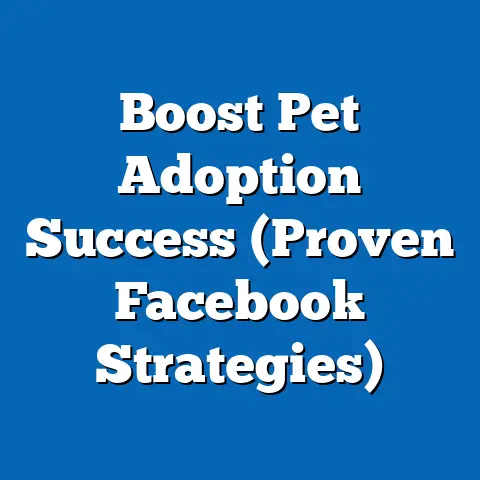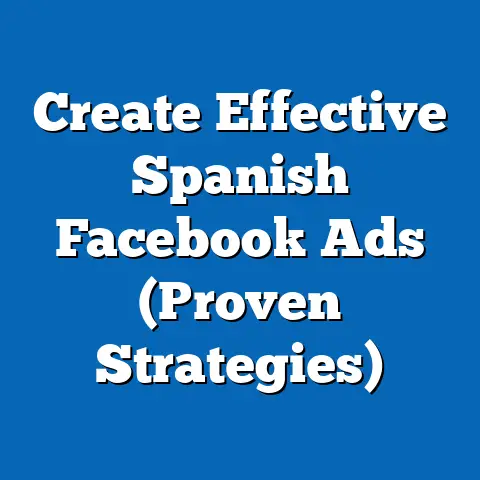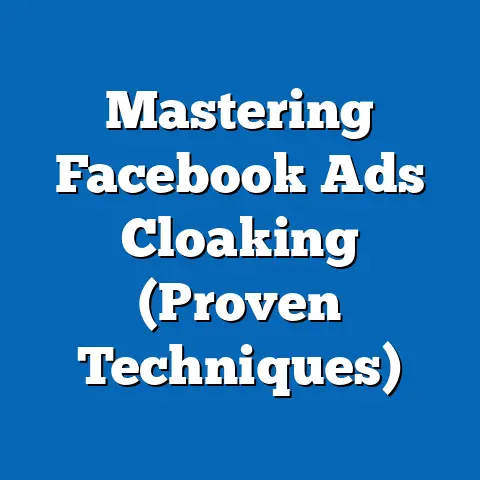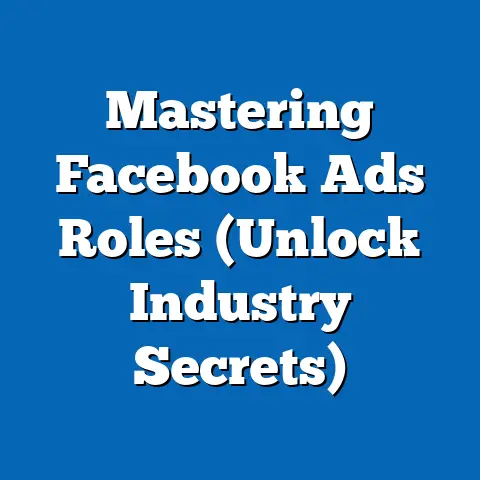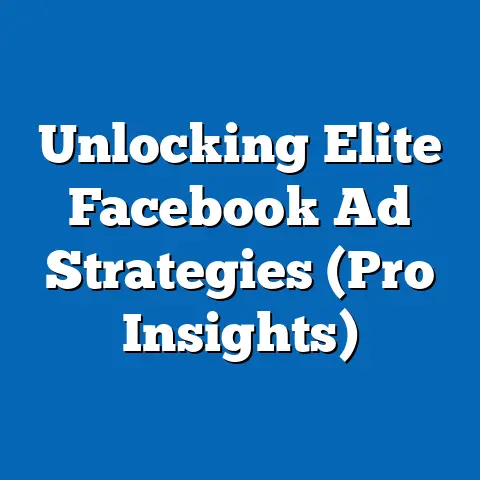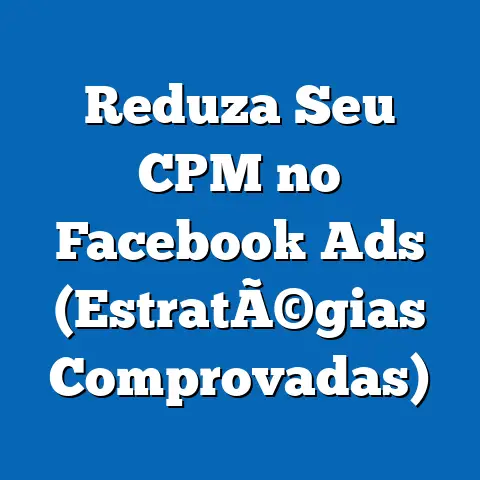Boost Amazon Author Ads on Facebook (Proven Strategies)
As an author, I know firsthand the challenges we face when trying to promote our books. The book market is fiercely competitive, and it’s easy for our ads to get lost in the noise, especially when relying solely on Amazon’s advertising platform. I’ve seen so many authors struggle to get their work noticed, which is why I started exploring other avenues. The limitations of staying within Amazon’s ecosystem became clear – we were missing out on the vast potential of social media, particularly Facebook, to connect with a broader audience.
Many authors feel overwhelmed by the complexities of Facebook advertising. I get it! It can seem like a whole different world. But I’m here to tell you that implementing strategic approaches can significantly boost your Amazon Author Ad performance and sales. Think of Facebook as a powerful amplifier, taking your Amazon ads and broadcasting them to a much larger and more targeted audience. In this guide, I’ll walk you through the proven strategies I’ve used (and continue to use) to successfully integrate Facebook advertising with my Amazon Author Ads, helping you reach more readers and ultimately, sell more books. It’s not about abandoning Amazon; it’s about augmenting it.
Understanding the Facebook Advertising Landscape
Facebook advertising is a beast, but a beautiful one when tamed. It’s not just about throwing money at ads and hoping for the best. It’s about understanding how the platform works and leveraging its powerful targeting capabilities. The beauty of Facebook lies in its ability to reach highly specific audience segments. You can target people based on their demographics (age, location, gender), interests (genres they enjoy, authors they follow), behaviors (online shopping habits, pages they like), and even create custom audiences based on your existing email list or website visitors.
Why is Facebook relevant to authors? Well, let’s look at the numbers. Facebook boasts billions of active users, many of whom are avid readers. Statistics consistently show high user engagement rates, meaning people are actively scrolling, clicking, and interacting with content. This presents a massive opportunity for authors to connect with potential readers where they already spend their time.
Integrating your Amazon Author Ads with Facebook campaigns is like creating a multi-channel marketing strategy. You’re not just relying on Amazon’s internal search engine; you’re actively driving traffic from Facebook to your Amazon book page. This can lead to increased visibility on Amazon, improved sales rank, and ultimately, more book sales. I’ve seen firsthand how a well-crafted Facebook campaign can breathe new life into an existing Amazon ad, leading to a significant uptick in sales. It’s about creating a synergy between the two platforms.
Key Takeaway: Facebook advertising provides unparalleled targeting capabilities and a vast audience for authors to reach potential readers beyond the Amazon ecosystem.
Crafting Compelling Ad Content
Here’s where the magic happens. You can have the best targeting in the world, but if your ad content is dull, no one will click. Creating eye-catching visuals and compelling copy is paramount to success on Facebook. Think of your ad as a mini-billboard for your book. It needs to grab attention in a split second and entice people to learn more.
- Visuals: Use high-quality images or videos that capture the essence of your book. Consider using professional-looking book covers, author headshots, or even short video trailers. I’ve found that visuals with people in them tend to perform better, as they create a more personal connection.
- Headlines: Your headline is your first (and sometimes only) chance to make an impression. Use strong, attention-grabbing language that speaks to the reader’s interests or emotions. Ask a question, make a bold statement, or highlight a key benefit of reading your book.
- Descriptions: Keep your descriptions concise and engaging. Highlight the unique selling points of your book, such as the genre, plot, or characters. Include a brief synopsis that leaves the reader wanting more.
- Call to Action (CTA): Don’t forget to include a clear CTA that directs users to your Amazon page. Use phrases like “Learn More,” “Buy Now,” or “Read Now” to encourage clicks. Make sure your CTA button is prominent and visually appealing.
I’ve seen ads that simply feature a book cover and a generic description fall flat. But when authors invest time in crafting compelling content, the results are often dramatic. For example, I worked with a fantasy author who created a short video trailer for her book, featuring stunning visuals and a dramatic voiceover. She used the headline “Escape to a World of Magic and Adventure” and included a CTA button that said “Discover the Realm.” This ad significantly outperformed her previous ads, resulting in a surge in book sales.
Key Takeaway: Compelling ad content, including eye-catching visuals and engaging copy, is crucial for attracting attention and driving clicks to your Amazon page.
Targeting the Right Audience
This is where Facebook’s advertising platform truly shines. It’s not enough to just have a great ad; you need to get it in front of the right people. Facebook offers a wealth of targeting options that allow you to reach specific audience segments based on their demographics, interests, behaviors, and more.
- Demographics: Target users based on their age, gender, location, education, and other demographic information. This is a good starting point, but it’s often too broad.
- Interests: Target users based on their interests, such as specific genres, authors, books, or hobbies. This is where you can really narrow down your audience and reach people who are likely to be interested in your book. For instance, if you write romance novels, you can target users who are interested in romance books, romance movies, or specific romance authors.
- Behaviors: Target users based on their online behaviors, such as their purchasing habits, the pages they like, or the groups they belong to. This can be a powerful way to reach people who are actively engaged in your niche.
- Custom Audiences: Create custom audiences based on your existing email list, website visitors, or app users. This allows you to target people who have already shown an interest in your work.
- Lookalike Audiences: Create lookalike audiences based on your custom audiences. Facebook will identify users who share similar characteristics to your existing customers, allowing you to reach a wider audience of potential readers. This is one of my favorite strategies!
I once worked with a science fiction author who was struggling to reach his target audience. He had a great book, but his ads weren’t performing well. I suggested he create a lookalike audience based on his email list. Within a week, his ad performance skyrocketed. He was reaching people who were genuinely interested in science fiction, and his book sales soared.
Key Takeaway: Facebook’s targeting options allow authors to reach highly specific audience segments based on their demographics, interests, behaviors, and more. Leveraging custom and lookalike audiences can significantly improve ad performance.
Budgeting and Bidding Strategies
Let’s talk money. Setting a realistic budget is crucial for running successful Facebook ad campaigns. You don’t need to break the bank, but you do need to invest enough to see results. The amount you spend will depend on your goals, your target audience, and the competitiveness of your niche.
- Daily vs. Lifetime Budget: You can choose to set a daily budget or a lifetime budget. A daily budget allows you to spread your spending evenly throughout the day, while a lifetime budget allows you to specify the total amount you want to spend over the duration of your campaign. I generally prefer daily budgets, as they give me more control over my spending.
- Bidding Strategies: Facebook offers a variety of bidding strategies, including automatic bidding and manual bidding. Automatic bidding allows Facebook to automatically set your bids based on your goals, while manual bidding allows you to set your bids yourself. I recommend starting with automatic bidding, as it’s easier to manage. As you gain more experience, you can experiment with manual bidding to optimize your ad spend.
- Optimizing Ad Spend: Monitor your ad performance closely and make adjustments as needed. If you’re not seeing the results you want, try tweaking your targeting, ad content, or bidding strategy. Don’t be afraid to experiment.
I’ve seen authors waste a lot of money on Facebook ads simply because they didn’t set a realistic budget or choose the right bidding strategy. It’s important to do your research and understand how the platform works before you start spending money. I often advise authors to start small and gradually increase their budget as they see results.
Key Takeaway: Setting a realistic budget and choosing the right bidding strategy are crucial for optimizing your ad spend and achieving better results on Facebook.
Analyzing and Optimizing Ad Performance
The work doesn’t end once your ad is live. You need to monitor your ad performance closely and make adjustments as needed. Facebook’s Ads Manager provides a wealth of data that can help you understand how your ads are performing.
- Key Performance Indicators (KPIs): Pay attention to key metrics such as click-through rate (CTR), conversion rate, and return on ad spend (ROAS). CTR measures the percentage of people who click on your ad after seeing it. Conversion rate measures the percentage of people who take a desired action (e.g., purchase a book) after clicking on your ad. ROAS measures the amount of revenue you generate for every dollar you spend on advertising.
- Facebook Ads Manager: Use Facebook’s Ads Manager to analyze your ad performance. The Ads Manager provides detailed reports on your ad impressions, clicks, conversions, and other key metrics.
- A/B Testing: A/B test different ad elements, such as visuals, copy, and targeting, to find the most effective combinations. This involves creating multiple versions of your ad and running them simultaneously to see which one performs best.
I’ve seen authors completely transform their ad performance simply by analyzing their data and making small tweaks to their campaigns. For example, one author noticed that her ads were performing much better on mobile devices than on desktop computers. She decided to focus her advertising efforts on mobile users, and her book sales skyrocketed.
Key Takeaway: Analyzing your ad performance and making data-driven decisions is crucial for optimizing your campaigns and achieving better results on Facebook. A/B testing different ad elements can help you identify the most effective combinations.
Conclusion
Leveraging Facebook ads to enhance the visibility of your Amazon Author Ads is a game-changer. It’s not about replacing your Amazon ads; it’s about amplifying them. By understanding the Facebook advertising landscape, crafting compelling ad content, targeting the right audience, setting a realistic budget, and analyzing your ad performance, you can effectively boost your book sales and reach a wider audience. It takes time, effort, and a willingness to experiment, but the rewards are well worth it.
I encourage you to start experimenting with Facebook ads for your Amazon Author Ads. Don’t be afraid to try new things and see what works best for you. The world of Facebook advertising is constantly evolving, so it’s important to stay up-to-date on the latest trends and best practices. And most importantly, don’t give up! With the right approach, you can achieve great success on Facebook and take your book sales to the next level.
Call to Action
Ready to take your Amazon Author Ads to the next level? Start experimenting with Facebook ads today! Share your experiences and results in the comments below or on social media using #AmazonAuthorAds and #FacebookAdvertising. I can’t wait to hear about your success stories!

